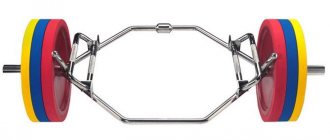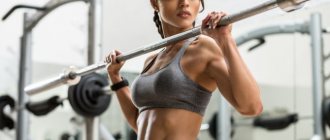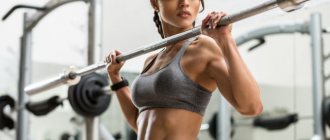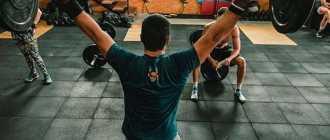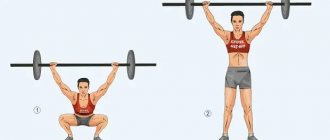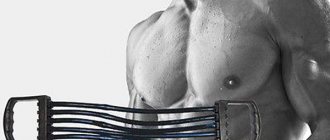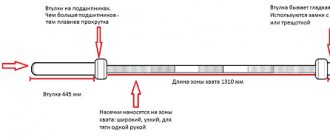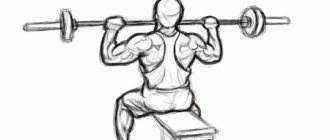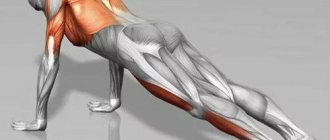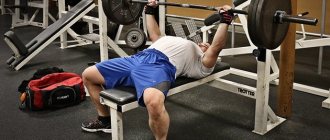The right home gym equipment is the key to a successful and enjoyable workout. How to choose barbell plates that are suitable for CrossFit?
CrossFit uses exercises from a variety of sports that have been proven effective in improving body quality and developing physical capabilities. So, it is known that strength training is one of the best ways to achieve these goals, so working with a barbell occupies an important place in CrossFit training.
The rods can be different: straight and curved, short and long, thick or standard. It all depends on what kind of neck makes up their base. But the bar also has another significant part - discs.
Plates or discs are a part of the barbell that allows you to change the weight of the projectile. Standard barbell weights are 10, 15 and 20 kg, when you need more you use weights mounted on the edges of the bar.
Pancakes also have another important purpose. Working on many strength elements requires the use of plates, as they hold the bar at the required level when the bar is on the floor. Some discs are designed just for this: their weight is minimal, 2.5-5 kg, but the diameter is standard. This allows you to assemble a full-fledged lightweight barbell based on any bar.
What types of weight plates are there?
The weight of weights for barbells has standard values: 50, 25, 20, 15, 10, 5, 2.5, 1.25, 0.75, 0.5 kg. But the outer and inner diameters may differ.
- Olympic weight plates have an outer diameter of 45 centimeters. Such discs may be rubber-coated or uncoated. Most often, powerlifting discs are not coated. Barbell discs are often painted in different colors. This is done for convenience. Approximate cost: from 300 to 3000 rubles per piece, the price depends on the weight of the disk. The more weight, the higher the cost.
- Rubberized weight plates are the most common among other options; they have an outer diameter of 37 centimeters, and an inner diameter of Olympic standard (51 mm) or standard (25 mm).
- Fitness discs are covered with thick black rubber. But since this category of disks is not standardized, disks can be found in different colors, with holes for carrying, of different thicknesses and shapes (circle or polyhedron), and even made of light alloys. Approximate cost: from 500 to 6000 rubles per piece, the price corresponds to the weight of the disk.
Diameter of weight plates
The most important indicator that you cannot make mistakes when choosing disks for a barbell is the diameter. Discs for rods have two such indicators: external, which is the actual diameter of the product, and internal, that is, the diameter of the sleeve.
Hole diameter
The internal diameter has several standards, which must be taken into account when choosing plates for a particular bar. This indicator depends on the thickness of the part of the neck on which it should be placed.
The Olympic bar, which is a recognized world standard, has a diameter of 50 mm at the disc attachment point, and a standard training bar has a diameter of 25 mm. Manufacturers also often produce bars with a diameter of 30 mm. The plates for all these bars will have a bushing diameter 1 mm larger so that the disc can be easily put on and taken off, but will not become loose during operation.
On the domestic equipment market you can purchase pancakes with the following internal diameter:
26 mm - American amateur standard
51 mm - Olympic standard
31 mm – discs are suitable for short or curved hyphae, rods of some manufacturers
28 mm - a standard that is not very common in Russia
55mm discs for some curved bars
External diameter
The outer diameter of the disk can have different values. Standard competition discs weighing more than 10 kg most often have a diameter of 45 cm. The organizers of the CrossFit Games during The Open suggested using 18-inch (45 cm) standard discs.
Fitness plates do not have a standard size. Manufacturers often use molds of different sizes for different disc weights; the lighter the disc, the smaller its outer diameter.
Small pancakes can have different weights, the most common are 1.25, 2.5 and 5 kg discs. Their sizes in the lines of most manufacturers depend on weight, but some polyurethane disks of these scales have one size.
Top 10 exercises with a weight plate
Squats with a plate
This type of squats is performed with one 15-20 kg weight plate. The disc must be held with both hands at chest level. Squats are performed until they are parallel to the floor, keeping your back straight by tensing your abdominal muscles. At the lowest point of the amplitude, a pause is maintained and the arms are pressed forward, straightening the elbows. Then the pancake returns to the chest and the torso is extended to its original position.
Thrusters
The pancake is held at the level of the collarbones with both hands from below for ease of pushing over your head. Place your feet slightly wider than your pelvis, elbows pointing to the floor, and the weight plate is at the level of your collarbones. Perform a squat until parallel to the floor, and at the top point, after straightening your torso, perform a swing with your arms above your head, fully straightening your elbows with the weight plate. Then return the plate to your collarbones and perform the squat again.
Farmer's Walk
Lunges around the gym are performed as usual: step one leg forward, the knee at the bottom point is at a right angle. Exhale as you straighten your front knee and shift your body weight to your other leg, stepping forward with it. The exercise is performed alternately with each leg. The only feature of the option is to hold the pancake above your head with straight arms for the entire approach.
Romanian single leg deadlift
Standing in a bent position with your legs bent, hold the plate with both hands at the edges. Then move one leg back slightly. Keeping your spine straight, bend forward while lifting your leg up. The supporting leg should be slightly bent. When bending, your arms should not strain; the pancake should fall approximately to the middle of the shin. Slowly return to the top point and continue rowing on one leg, then switch to the other.
Front swings with a pancake
Hold the plate at your sides with both hands, placing the bottom edge of the plate on your thighs. Bend your elbows slightly. Stand straight, without swaying, with your knees slightly bent. Exhale and lift the weights in front of you with your palms level with your eyes, without changing the angle of your elbows. Slowly lower the bar without touching your hips.
Lateral bends
The exercise is performed alternately on each side with one pancake. Take the plate in your right hand and hold it loosely without bending your elbow. Place your feet hip-width apart and place your free hand behind your head. As you inhale, tilt your torso to the side, stretching the oblique abdominal muscles, and exhale, return to the starting position using your abdominal muscles.
Chest press
It's easy to do. Standing with your feet shoulder-width apart, holding the plate with both hands, lift it to chest level. Exhale and push the disc in front of you, straightening your elbows completely. As you inhale, gently return your arms to your chest without swaying.
Belt pull
Place your feet hip-width apart and grab the disc with both hands. Lean forward with a straight spine, bending your knees slightly. Hands with a pancake hang down freely. As you exhale, stretch the disc towards your stomach, bringing your elbows as close to your body as possible. At the same time, pull the disc with your back muscles, feeling the contraction of your shoulder blades. As you inhale, slowly lower the disc, straightening your elbows. Do not change the position of your body throughout the entire approach and do not sway.
Sitaps
The exercise is performed lying down, holding the pancake at your sides in your hands. In the starting position, the pancake is behind the head, arms slightly bent at the elbows. Feet on the floor, knees bent. As you exhale, twist with the force of your abdominal muscles, lifting the pancake from behind your head, and during the lifting, bring it to your chest, and at the top point, lift the disc above your head, straightening your elbows. Then smoothly return to your back, gradually lowering your hands behind your head.
Russian twist
Sitting on your buttocks, knees bent, heels touching the floor. Hold the plate in both hands at your sides at chest level. Lean back slightly and twist from side to side using your obliques. At the same time, do not lean back too much and do not arch your lower back. The abdominal muscles should be constantly tense.
Varieties of pancakes
Discs can be classified according to production technology and materials:
Rubber-coated steel discs have a soft coating, making them more comfortable to work with. Such products are often used for powerlifting and weightlifting. They can be black or colored to make it easier to determine their weight.
Discs made of polyurethane, rubber and rubber with a metal cylinder at the attachment point are softer and more durable products that are wider than steel ones. These discs are best suited for crossfit; they can be used in a gym where there is no weightlifting platform. Most often they have a black or colored coating to make it easier to determine their weight. Some manufacturers also offer wheels made from uncoated compressed crumb rubber. These products have a characteristic appearance, can bend slightly, but they are cheaper and, with proper quality, are quite suitable for training.
Plastic discs: are made of plastic and are relatively lightweight. They have a standard outer diameter of typically 26 mm. Such plates can be used for training athletes who only need light weight, but who find it inconvenient to lift it from the floor.
Discs (pancakes) for barbells: what are they?
For barbells, it is best to purchase plates (they are also called discs) ready-made. These things require special precision in size and weight, therefore, their production requires only specialized equipment and a craftsman who is competent in this work.
Today in stores there is a choice of weight plates in unlimited quantities. You can make a choice based on the price grid, but you don’t always need to chase the most expensive disks. Shiny wheels are among the most expensive, but sometimes it’s worth thinking about which wheels are still worth buying and whether it’s worth chasing the high cost.
First you need to find out what kind of disks there are in general.
Firstly , pancakes are characterized by their weight, they come in 0.5; 1.0; 1.25; 1.5; 2.0; 2.5; 3.0; 5.0; 10.0; 12.0; 15.0; 20.0; 25.0; 50.0 kg. Sometimes pancakes weighing 100 grams are needed. and 250g., this happens extremely rarely, and they are not often found on sale, but they can be safely ordered from the factory. Sometimes they can be purchased with fasteners in a store, and they look like washers. The most popular are pancakes weighing 2.5; 5.0 and 10.0 kg. All the most commonly used steps in weight gain are achieved with 0.5 kg and 1.0 kg plates. To do this, you need to have at least a couple of pancakes of 0.5 kg and at least four of 1 kg. If the line on the bar exceeds a hundredweight, then you can safely purchase pancakes weighing 25.0 kg and 50.0 kg. If you have extra funds on hand, you can fork out money for pancakes of other scales; iron sales also fall into this category.
Secondly , the diameter of the mounting hole is characterized by a pancake; the holes are 25, 30 and 50 mm. The most common diameters are 25 and 50 mm. The price for such discs is the same, but if a person is working for the future, then it is better to purchase discs with a diameter of 50 mm right away, since this size is universal. By making an adapter sleeve, you can easily work on various 25 mm and 30 mm bars. The bushing can be made from various materials, or rather from those as far as your imagination goes. Sometimes the plate is hung without an adapter, in this case you need to be careful and you should not do exercises from the floor, since injuries in this case are inevitable.
Thirdly , you need to pay attention to the outer diameter of the disk, because because of this parameter, pancakes can be thin and thick. By increasing its circumference, the fixed weight of the pancake can be stretched. For pancakes with a large outer diameter, it is better to choose thin ones. And their advantages are obvious, since they can be loaded more on the barbell and deadlifts in this case are easier to do, and the barbell, due to the large diameter of the plates, is located high above the floor.
The presence of shock absorbers on the discs plays an important role. The cheapest wheels are simply iron, they have no shock absorbers. This is very inconvenient, since such discs damage the floor surface and also rust.
Pancakes with a rubber shock-absorbing strip are much more convenient, although without proper care they will rust. Converter wipe and paint are necessary measures to prevent rust.
The most ideal pancakes are those that are completely wrapped in plastic or rubber. It’s nice to even pick them up - no traces of impact, no maintenance costs, a significant price is the main drawback, and even the marks on the floor left by a pancake rolled up in rubber.
The individualizing feature of pancakes is color and shape.
Choosing weight plates for your own gym
It would seem that what could be special about a simple piece of iron? However, your opinion changes dramatically if you are planning to open your own gym and immerse yourself in the topic.
Especially for you, we decided to write an educational program on disks for classic commercial halls.
Why is it so narrow – “for classic commercial halls”? Everything is very simple. In fact, there are so many different groups and subgroups of disks that it is quite possible to write a whole treatise. There are commercial and home discs, and then there are different types for each type of activity. We won’t bore you and move on to what you need.
There are two large groups of weight plates: cast iron and rubber plates. Let's look at their main differences, pros and cons.
Quiet and comfortable
Today, rubber-coated discs are often chosen for use in commercial halls. What are these gym owners' favorites? A steel blank covered with a layer of rubber with a bushing in the center. By the way, how discs recommended for home use differ from professional ones is the hub. Pancakes intended for home use have a rubber sleeve, while professional ones have a steel sleeve. In the gym, athletes will take off and put on discs on the bar several dozen, or even hundreds of times; a steel bushing cannot withstand such loads. But rubberized ones may begin to peel off over time, which will not happen at home.
Another separate group includes discs of the Euro-classic category. These are also rubberized pancakes, which, however, have holes for the hands. This way, you can easily carry discs around the room.
They buy rubberized wheels because of their maximum convenience. The first and most obvious advantage is that they are practically silent and this is an undoubted bonus that makes living in your room comfortable. The second advantage is their rubber coating, which makes the surface softer, translating this into pragmatic language - if a pancake falls on the floor, nothing will happen to either the pancake or the floor.
Among the minuses, we highlight the higher price than cast iron discs and the fact that they are thicker than their counterparts, which means that fewer of them can be put on the bar.
Savings and durability
Cast iron discs are as simple as possible in their essence - it’s just a pancake completely cast from cast iron, no tricks.
What are its advantages? Firstly, of course, this is the price, which is an order of magnitude lower than rubberized disks. If you are looking for inexpensive weight plates, this is a great option.
Secondly, their incredible strength, they do not deform, nothing will happen to them. If you can scratch a rubber-coated disc, nothing will happen to a cast-iron one. However, it is worth considering that if you throw a disk of 20 kg or more on a concrete floor, you will have two pieces of iron weighing 10 kg each.
Thirdly, cast iron discs are thinner, so you can put more of them on the bar.
One of the disadvantages is the noise of discs hitting each other, however, if you have a weight room with real athletes, they will not suffer from this. Well, don’t throw them anywhere other than the platform, otherwise you’ll have to buy a new pancake and floor covering.
Instead of an afterword
In fact, a lot depends on the individual tastes of each hall owner. Therefore, take note of our article, but be guided by your own opinion. Have a good workout.
